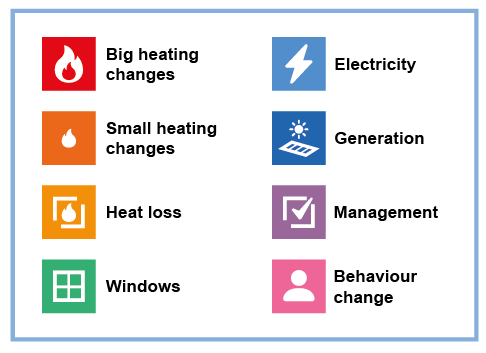The cards#
There are 56 cards in total. They fall into 8 categories identified by colour, with one wildcard. The wildcard is to remind people that we won’t have thought of every possible action a group could take.

Our groups are highly varied:
there are modern buildings and traditional ones (many listed or with special features like stained glass windows)
they use their spaces constantly, or once a week
the group members are all involved in running the organisation, or they are mostly people from the local neighbourhood
they use different kinds of heating and different heating strategies
some are up for big retrofits; some are mostly looking for things they can do immediately
The cards reflect this range. Not all actions will be appropriate for all groups. This makes it hard to give good tailored explanations for them. Groups need to keep this in mind as they think about the cards, and take professional advice, especially when it comes to older buildings, to avoid damaging their buildings through inappropriate treatment. The role of the engineer in the group isn’t to provide this advice. Engineers are used to thinking about project management, budgets, and how to choose among different options. The engineer is here to try to help guide the process and to be the “game master” who has at hand the explanations of what the cards mean.

Each card describes an action the group could take and is labelled with a cost level from 1 to 5, shown in a circle, and a carbon savings level from 1 to 5, shown in a star. Our buildings differ so much even just in size that the levels don’t correspond to any particular amount of money or carbon savings. The cost levels are intended to reflect the level of planning a group might need to do to bring about the change:
actions the group might decide to just go ahead and do immediately
actions that might only take delegated decisions to a property management committee
in-between actions
actions where groups are likely to have to raise funds via the community or grants
actions likely to require substantial grant fund-raising and planning, including evidence of community engagement events and donations from the local community
The levels are very rough and we won’t have them all correct. Our current judgments are probably biased towards traditional buildings in occasional use. We sometimes include a card because we get asked about the action frequently, even if we think the action is unlikely, and maybe we shouldn’t. Our ratings and the list of actions itself is something we expect we can improve during the programme.





